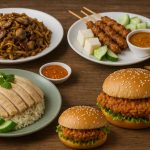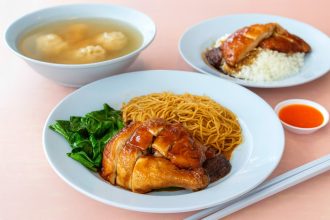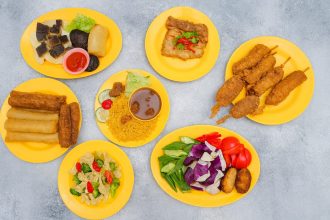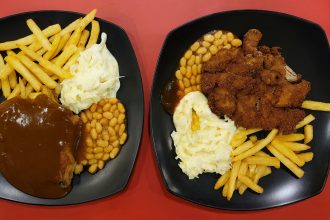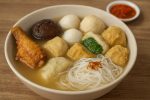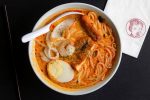Address: 335 Smith Street, #02-017, Chinatown Complex Food Centre, Singapore 050335
Beneath the rattle of chopsticks and the chatter of lunchtime crowds lies a stall with no gimmicks, no trends, and no shortcuts. Just honest soup—slow-simmered in clay pots over glowing charcoal. Herbal Soup (瓦罐煨汤), housed in Singapore’s Chinatown Complex, doesn’t announce itself loudly. It doesn’t need to. The aroma of brewed herbs and smoked broth does the work.
Charcoal and Clay: A Cooking Method with Weight
Herbal Soup makes one promise: tradition upheld. Each soup is slow-cooked over a charcoal flame using clay pots, a method rarely seen in hawker centres. Charcoal cooking creates a consistent, penetrating heat. Clay pots seal in moisture and nutrients. Together, they produce broth with depth, body, and character that modern pressure cookers or induction burners can’t imitate.
This technique traces back to Nanchang, Jiangxi Province, where slow cooking wasn’t a choice—it was the only way to coax flavors and extract healing properties from roots, berries, and barks. Every pot here simmers for hours. Nothing is rushed. The result? A thick, fragrant broth that stays hot, with meat tender enough to fall apart on the spoon.
26 Soups, Each with a Purpose
Up to 26 varieties rotate through the menu board. Prices begin at just S$4, making these soups as accessible as they are nourishing. Some popular choices include:
- Herbal Black Chicken Soup – Silky, dark meat infused with herbs known for their energizing properties.
- Sweet Corn Pork Ribs Soup – Light, naturally sweet, good for humid days.
- Black Bean Pork Ribs Soup – Rich and earthy, traditionally associated with kidney support.
- Black Bean Pig’s Tail Soup – A heartier bowl, prized for its collagen content.
Each bowl arrives brimming with ingredients. No watered-down broths, no token herbs. The portions are hearty, often enough to stand as a full meal.
Complimentary Ginseng and Liquorice Root Tea
After ladling up a steaming bowl, the stall offers a free cup of ginseng and liquorice root tea. This gesture isn’t an afterthought. Ginseng warms. Liquorice cools. Together, they balance. In Traditional Chinese Medicine (TCM), it’s a way to restore equilibrium after a hot, yang-filled meal.
Why Herbal Soup Matters
These soups aren’t just about comfort. They follow centuries-old TCM principles that view food as the first line of health care. Ingredients are chosen not just for flavor, but for their effects on the body. Here’s a breakdown of what goes into the pot—and what each component is believed to do.
Core Ingredients and Their Roles
- Ginseng – Stimulates energy, boosts mental alertness, and supports physical stamina.
- Red Dates – Used to “nourish the blood” and aid digestion.
- Goji Berries – Linked to improved eye health, immunity, and anti-aging benefits.
- Chinese Yam – Often used to strengthen the spleen and stomach, and improve qi.
- Black Beans – Associated with kidney health and replenishing blood.
The stall doesn’t hide behind novelty. There’s no fusion, no gimmick flavors. Every soup has purpose. Every bowl is aligned with the idea that what you eat can shape how you feel.
A Routine for Many, a Nostalgia Trip for Others
Lunchtime sees long queues. Regulars return for weekly doses of Black Chicken Soup or a gentle Pork Ribs and Lotus Root broth. For older patrons, the charcoal-fired pots spark memory—of grandmothers slow-cooking through the afternoon, of apothecary kitchens and bubbling medicine cabinets.
The smoky scent is a time capsule. So is the sight of bubbling brown clay pots aligned in rows, steam wafting up as the stall keeper gently lifts each lid. It’s less hawker, more alchemy.
Why Charcoal Matters
Charcoal cooking doesn’t just heat. It transforms. The fire licks the base of each pot, creating subtle layers of flavor. A slightly bitter herbal root softens. Sweetness intensifies. It also keeps temperature steady over time—no sharp spikes, no electric buzz. The result is a brew that tastes steeped in patience.
The method requires vigilance. Too much fire, the soup scorches. Too little, it’s undercooked. Staff adjust the embers with instinct, not timers. The process rewards those who tend to it—not those looking for shortcuts.
No Signboard Needed
You won’t find flashing lights or food awards hanging at the stall. There’s a simple menu with Chinese characters and English translations. The clay pots do the talking. The regulars nod in approval. The newcomers follow their noses.
For First-Timers: What to Try
If you’re visiting for the first time, try this sequence:
- Start with Herbal Black Chicken Soup – It’s the stall’s signature and a strong base point.
- Next time, go for Sweet Corn Pork Ribs Soup – Lighter and slightly sweet, perfect if you’re unsure about stronger herbal notes.
- If adventurous, ask for Black Bean Pig’s Tail Soup – A deeper, fattier broth with chewy textures and a dose of gelatin.
Pair each with a side of white rice. Sip the tea slowly. Let the heat settle into your body.
More Than Soup, It’s Cultural Preservation
As the city changes, places like Herbal Soup remind us what food once was: medicine, ritual, comfort, and nourishment. The charcoal burns slow. The pots bubble away. The soup isn’t reinvented—it’s remembered.
You won’t find QR codes or fancy branding. Just herbal broth, built from memory and method. Amidst rows of modern stalls and fast-food chains, Herbal Soup stands firm, ladle in hand.
If you’re looking for something nourishing, authentic, and made with patience, head up to the second floor of Chinatown Complex. The clay pots are waiting.


